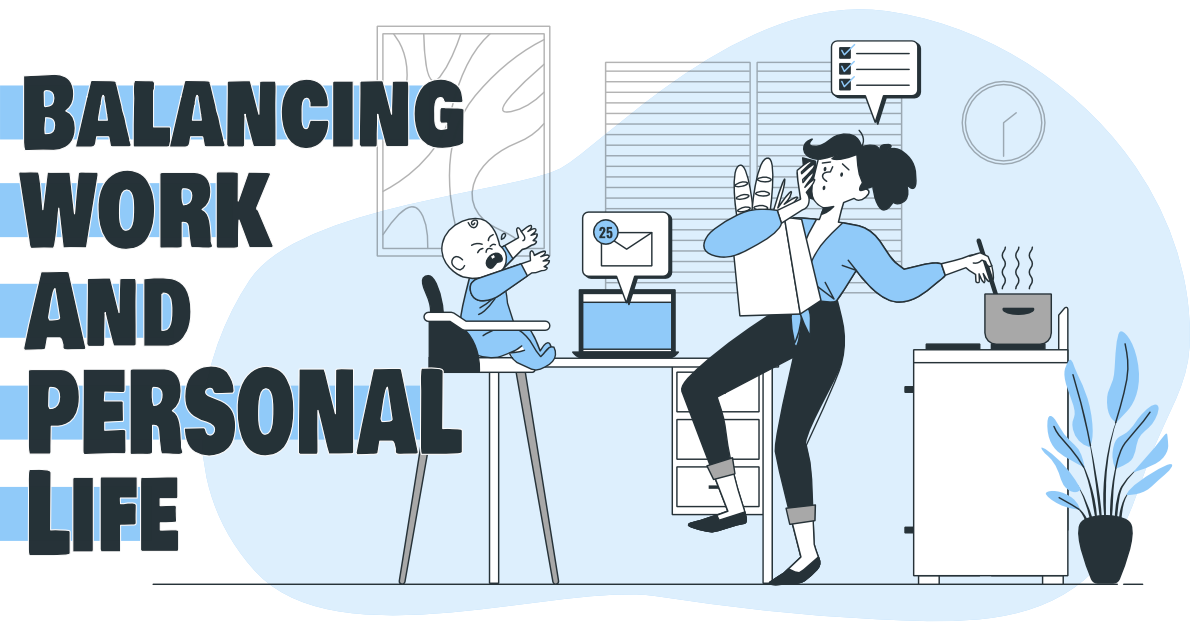Balancing work and personal life is a crucial aspect of being an entrepreneur. It’s essential to find a harmonious balance between work and personal life to avoid burnout, stress, and loss of productivity. It’s also necessary to prioritize personal relationships and self-care to maintain a healthy and fulfilling life. This sub-topic will cover strategies and best practices for balancing work and personal life as an entrepreneur, as well as tips for maintaining a healthy work-life balance in the face of various challenges.
Understanding the importance of balancing work and personal life
Balancing work and personal life is a critical challenge for entrepreneurs, especially when they are starting a business or expanding it. As an entrepreneur, you may find yourself working long hours and dedicating all your time and energy to your work, which can lead to burnout and negatively impact your personal life. Understanding the importance of balancing work and personal life is crucial for entrepreneurs to maintain their health and happiness, increase productivity, and maintain positive relationships with their loved ones.
Balancing Work and Personal Life as an Entrepreneur:
Step-by-Step Guide
- Identify and prioritize personal values: Take the time to identify and prioritize your personal values, such as family, health, and leisure time. This will help you to understand what is important to you and what you need to prioritize in your life.
- Set boundaries: Set clear boundaries between your work and personal life by determining specific work hours and scheduling time for family, friends, and leisure activities. This will help you avoid overworking and reduce stress.
- Plan your schedule: Plan your schedule in advance, taking into account your work and personal commitments. Use tools such as calendars, to-do lists, and scheduling apps to help you stay organized and on track.
- Make time for self-care: Make time for self-care activities such as exercise, meditation, and hobbies, to help you maintain your health and well-being.
- Learn to say no: It is essential to learn how to say no to work-related commitments that are not essential or that can be postponed. This will help you to avoid overloading your schedule and reduce stress.
- Maintain a positive work-life balance: Regularly evaluate your work-life balance to ensure you are maintaining a healthy balance between work and personal life.
Examples and Best Practices
- Take breaks during the workday to recharge and avoid burnout.
- Turn off work notifications after work hours to avoid work-related stress and distractions.
- Delegate tasks to other team members when necessary to free up time for personal life.
- Schedule family time and date nights to maintain strong relationships with loved ones.
Conclusion
Balancing work and personal life is crucial for entrepreneurs to maintain their health and happiness, increase productivity, and maintain positive relationships with their loved ones. By following the steps outlined in this guide, entrepreneurs can create a balanced and fulfilling life that allows them to achieve both personal and professional success.
Strategies for setting boundaries and creating a healthy work-life balance
Balancing work and personal life can be challenging, especially for entrepreneurs who often have to work longer hours and handle multiple responsibilities. Setting boundaries is crucial in creating a healthy work-life balance. In this article, we will discuss effective strategies for setting boundaries and creating a balance between work and personal life.
Step-by-Step Guide
- Identify your priorities: It is essential to identify what is most important to you in life and determine how you want to allocate your time. Write down your priorities and use them as a guide when making decisions about how to spend your time.
- Schedule your time: Create a schedule that includes dedicated time for work, family, friends, and leisure activities. Make sure to stick to your schedule and prioritize activities that align with your priorities.
- Set boundaries for work: Set boundaries for work by deciding when you will start and finish work each day, taking breaks, and setting aside time for personal activities. This will help you maintain a healthy work-life balance and prevent burnout.
- Learn to say no: It can be challenging to say no to work requests, but it is essential to set boundaries and prioritize your time. Saying no to non-essential tasks and commitments will give you more time to focus on what is important to you.
- Delegate tasks: Delegating tasks to others can help you reduce your workload and give you more time for personal activities. Identify tasks that can be delegated and find the right people to help you.
- Use technology to your advantage: There are many tools and apps that can help you manage your time more effectively and maintain a healthy work-life balance. For example, you can use a time-tracking app to monitor your work hours and manage your schedule, or a task management app to prioritize your tasks and keep track of deadlines.
Examples
- A freelance graphic designer who sets aside dedicated time for work, family, and leisure activities, and uses a time-tracking app to monitor work hours.
- An entrepreneur who schedules time for exercise, reading, and hobbies, and delegates non-essential tasks to staff members to reduce their workload.
Best Practices
- Set realistic and achievable goals
- Prioritize self-care and personal well-being
- Avoid working late nights and weekends, if possible
- Seek support from family, friends, and colleagues when needed
Actionable Tips
- Take regular breaks throughout the day to recharge and avoid burnout
- Plan fun activities with family and friends to maintain strong relationships
- Find ways to make work enjoyable and fulfilling, such as incorporating your hobbies and interests into your work
Conclusion
Balancing work and personal life can be challenging, but it is essential to maintain a healthy work-life balance. By setting boundaries, delegating tasks, and using technology to manage your time effectively, you can create a balance that works for you. Additionally, prioritizing self-care, seeking support, and making time for leisure activities can help you stay motivated and avoid burnout.
Tips for managing time effectively to balance work and personal commitments
Balancing work and personal life is a challenge that many entrepreneurs face. When running a business, it can be easy to become consumed by work, leaving little time for family, friends, and self-care. This can lead to burnout and negatively impact both personal and professional life. Time management is key to finding balance, ensuring that work and personal commitments are fulfilled without sacrificing one for the other.
Step 1: Evaluate and Prioritize
The first step in managing time effectively is to evaluate your current commitments. This includes both work and personal tasks. Make a list of everything you need to do, and prioritize each task based on importance and urgency. Once you have a clear understanding of your commitments, you can determine what needs to be done first and allocate time accordingly.
Step 2: Create a Schedule
The next step is to create a schedule. This should include time for work, self-care, and personal life. Be realistic about the amount of time each task will take and allocate enough time to complete it effectively. To ensure balance, it’s important to schedule in time for personal commitments such as family time, exercise, and self-care activities.
Step 3: Stick to the Schedule
Once you have created a schedule, it’s important to stick to it. This can be challenging, especially when work demands increase, but staying committed to your schedule will help you achieve balance. Set boundaries, communicate your schedule to coworkers, and prioritize the tasks that are most important.
Step 4: Use Tools and Technology
There are several tools and technologies available to help entrepreneurs manage time more effectively. For example, calendar apps and task management tools can help you keep track of appointments, deadlines, and to-do lists. Time tracking apps can help you see where your time is being spent and make adjustments as needed.
Best Practices
- Schedule in downtime and self-care activities
- Set boundaries and communicate your schedule
- Use tools and technologies to help manage time
- Prioritize important tasks and stick to your schedule
Real-life Scenario
As a busy entrepreneur, Sarah found herself struggling to balance work and personal life. She was constantly feeling overwhelmed and burnt out. To solve this problem, she evaluated her commitments and created a schedule that included time for work, self-care, and personal life. She also set boundaries, communicated her schedule to coworkers, and used time tracking apps to help manage her time. As a result, she was able to achieve balance and felt more fulfilled both personally and professionally.
Actionable Tips
- Make a list of all your commitments
- Evaluate and prioritize your tasks
- Schedule in time for self-care and personal life
- Use tools and technologies to help manage time
- Set boundaries and communicate your schedule
- Stick to your schedule and adjust as needed
Conclusion
Balancing work and personal life is a challenge for many entrepreneurs, but it is possible with effective time management. By evaluating and prioritizing commitments, creating a schedule, and using tools and technology, entrepreneurs can achieve a healthy work-life balance. It’s important to set boundaries, communicate your schedule, and stick to your schedule in order to achieve balance.
How to create a schedule that prioritizes both work and personal life
Balancing work and personal life is a key challenge for entrepreneurs, especially for those who are starting out. A schedule that prioritizes both work and personal life is crucial to maintain a healthy work-life balance. A well-organized schedule can help entrepreneurs manage their time effectively, reduce stress and increase their productivity. In this article, we will explore the steps involved in creating a schedule that prioritizes both work and personal life.
Step-by-Step Guide
- Identify your priorities: Before creating a schedule, it is important to identify your priorities. Make a list of your most important work tasks and personal commitments and prioritize them. This will help you allocate your time effectively.
- Allocate time for work and personal life: Allocate a specific amount of time for work and personal life. For example, allocate 8 hours for work and 8 hours for personal life. Ensure that the work hours are divided between your most important work tasks and allocate the rest of your time for personal activities.
- Use a scheduling tool: Use a scheduling tool such as Google Calendar, Trello, or Asana to manage your schedule. These tools help you keep track of your tasks, deadlines, and appointments. You can also set reminders to help you stay on track.
- Plan your day: Plan your day by setting aside time for your most important tasks. Start with your most important work tasks and then allocate time for personal activities. Be realistic with your time allocation and don’t overcommit yourself.
- Leave room for flexibility: It is important to leave room for flexibility in your schedule. Emergencies and unexpected events may arise, and it is important to have the ability to adjust your schedule accordingly.
- Review and adjust your schedule regularly: Regularly review and adjust your schedule to ensure that you are achieving your desired work-life balance. Make changes as necessary to accommodate new tasks and priorities.
Examples
- An entrepreneur who runs a small online store can allocate 8 hours for work and 8 hours for personal activities. The work hours can be divided between managing the online store, marketing, and customer service. The personal hours can be used for exercise, hobbies, and spending time with family.
- A freelancer who provides consulting services can allocate 6 hours for work and 10 hours for personal life. The work hours can be used for client work and the personal hours can be used for personal activities such as exercise, hobbies, and spending time with family.
Best Practices
- Start your day with the most important tasks.
- Set realistic goals and deadlines.
- Avoid overcommitting yourself.
- Take regular breaks to recharge and refocus.
- Set aside time for self-care activities such as exercise and meditation.
Actionable Tips
- Make a to-do list for each day and prioritize the tasks.
- Use a scheduling tool to keep track of your tasks, deadlines, and appointments.
- Take regular breaks to recharge and refocus.
- Make time for personal activities such as exercise and hobbies.
- Review and adjust your schedule regularly to ensure that you are achieving your desired work-life balance.
Conclusion
Balancing work and personal life is crucial for entrepreneurs. By creating a schedule that prioritizes both work and personal life, entrepreneurs can manage their time effectively, reduce stress and increase their productivity. A well-organized schedule helps entrepreneurs maintain a healthy work-life balance and achieve their desired goals. Regularly reviewing and adjusting your schedule is key to ensuring that you are achieving your desired work-life balance.
The role of self-care and mental well-being in balancing work and personal life
Balancing work and personal life as an entrepreneur is crucial for both professional and personal success. Achieving a healthy work-life balance can lead to increased productivity, improved mental well-being, and a more fulfilling personal life. However, it can be challenging for entrepreneurs, who often put a significant amount of time and energy into their business, to prioritize self-care and mental well-being while still reaching their goals. In this article, we’ll explore the role of self-care and mental well-being in balancing work and personal life as an entrepreneur.
Self-care and mental well-being play a critical role in balancing work and personal life. Taking care of oneself mentally and physically can reduce stress levels, increase energy and motivation, and help to maintain a healthy work-life balance. Regular self-care activities such as exercise, meditation, and relaxation can help entrepreneurs to recharge and rejuvenate, allowing them to approach their work with renewed focus and determination.
Entrepreneurs often face a lot of pressure, stress, and long hours. If left unaddressed, this stress can lead to burnout, decreased motivation, and reduced productivity. Self-care and mental well-being can help entrepreneurs to avoid these negative outcomes by providing a way to manage stress and maintain a healthy balance between work and personal life.
How to incorporate self-care and mental well-being into your work routine?
- Make time for self-care activities: Schedule self-care activities into your daily routine, such as exercise, meditation, or a relaxing hobby.
- Prioritize sleep: Aim for 7-9 hours of quality sleep each night to improve mental clarity and reduce stress levels.
- Take breaks throughout the day: Step away from your work every hour or two to stretch, take a walk, or simply take a break from the screen.
- Seek support: Connect with friends and family for emotional support, or consider therapy or counseling if necessary.
- Avoid burnout: Avoid overworking yourself by setting realistic goals and delegating tasks when necessary.
Examples and Best Practices
- An entrepreneur, Sarah, schedules an hour of yoga into her daily routine and makes time for a weekly therapy session to maintain her mental well-being. She also sets boundaries for work, such as not checking emails after a certain time in the evening, to avoid burnout and prioritize her personal life.
- Another entrepreneur, Michael, takes 10-minute breaks every hour to stretch and go for a walk to clear his mind and reduce stress. He also prioritizes sleep by making sure to get at least 8 hours of sleep each night and makes time for family activities on the weekends.
Conclusion
In conclusion, self-care and mental well-being play a crucial role in balancing work and personal life for entrepreneurs. Incorporating self-care activities into your routine, prioritizing sleep, taking breaks, seeking support, and avoiding burnout can help entrepreneurs maintain a healthy work-life balance and avoid negative outcomes such as burnout and decreased motivation.
How to set and achieve goals that align with your values and priorities
Setting goals and working towards them is a vital aspect of personal and professional development. But, often, people set goals that do not align with their values or priorities, which can lead to frustration and burnout. In this article, we will delve into the importance of setting and achieving goals that align with your values and priorities.
Step-by-Step Guide
- Identifying your values and priorities: The first step to setting goals that align with your values and priorities is to know what these are. Take some time to reflect on what is most important to you and what drives you. You can use tools such as journaling or goal-setting worksheets to help you define your values and priorities.
- Creating SMART goals: Once you have identified your values and priorities, the next step is to create specific, measurable, achievable, relevant, and time-bound (SMART) goals that align with them. Ensure that your goals are realistic and achievable within a specified timeframe.
- Breaking down big goals into smaller steps: Large goals can be overwhelming, so breaking them down into smaller steps can make the process less intimidating. By breaking down your goals into smaller steps, you can make progress towards them more manageable and achievable.
- Incorporating self-care and mental well-being into your goals: Self-care and mental well-being should be a priority when setting and working towards your goals. Ensure that you make time for activities that support your well-being, such as exercise, mindfulness practices, and spending time with loved ones.
- Celebrating progress and adjusting goals as needed: Celebrating your progress towards your goals can provide motivation and a sense of accomplishment. Additionally, it’s essential to adjust your goals as needed, especially if they no longer align with your values and priorities.
Best Practices
- Make your goals meaningful: Ensure that your goals are meaningful to you and align with your values and priorities. This will make it easier to stay motivated and work towards them consistently.
- Write down your goals: Writing down your goals makes them more concrete and easier to remember. You can use a goal-setting journal or an app to keep track of your progress.
- Review your goals regularly: Regularly reviewing your goals will help you stay on track and make any necessary adjustments.
- Surround yourself with supportive people: Surrounding yourself with people who support and encourage your goals can make the journey towards them more enjoyable and less stressful.
Actionable Tips
- Start small: Don’t overload yourself with too many goals at once. Start small and gradually add more as you make progress.
- Prioritize your goals: It’s essential to prioritize your goals based on their significance and urgency. Focus on the most important ones first, and then move on to the others.
- Stay flexible: Life is unpredictable, and your goals may need to change as circumstances change. Stay flexible, and don’t be afraid to adjust your goals as needed.
Conclusion
Setting and achieving goals that align with your values and priorities is an essential aspect of personal and professional development. By following the steps outlined in this article, you can set achievable goals, incorporate self-care and mental well-being into your goals, and celebrate your progress along the way. With persistence and dedication, you can reach your goals and live a fulfilling life.
The importance of delegating and outsourcing to free up time for personal life
Balancing work and personal life is crucial for the overall well-being and success of entrepreneurs. Delegating tasks and outsourcing non-core functions can help entrepreneurs free up time for their personal life and reduce stress levels.
What is Delegation and Outsourcing
Delegation involves assigning tasks to others within the organization, while outsourcing involves hiring outside parties to perform certain functions. Both delegation and outsourcing are crucial tools for entrepreneurs to manage their workload effectively.
Why Delegation and Outsourcing are Important
Entrepreneurs often struggle to balance their work and personal life due to an overwhelming workload. By delegating and outsourcing tasks, entrepreneurs can focus on their core responsibilities, prioritize their time, and reduce stress levels. Additionally, outsourcing can help entrepreneurs save time and money as they can hire experts to perform specific functions more efficiently and cost-effectively than they could in-house.
Step-by-Step Guide
- Identify non-core functions: Entrepreneurs should determine which tasks are not crucial to the success of their business and can be delegated or outsourced.
- Evaluate the workload: Entrepreneurs should assess their workload and determine which tasks take up the most time. These tasks should be given priority when it comes to delegation or outsourcing.
- Choose delegation or outsourcing: Entrepreneurs should decide whether to delegate tasks within their organization or outsource them to outside parties. The decision should be based on the nature of the task and the resources available.
- Hire experts: If outsourcing, entrepreneurs should seek out experts in their field who can perform the task efficiently and cost-effectively.
- Define expectations: Entrepreneurs should clearly define expectations and set deadlines for the tasks delegated or outsourced.
- Monitor progress: Entrepreneurs should regularly monitor the progress of delegated or outsourced tasks to ensure that they are completed on time and to the desired standard.
Real-life Scenario
A small business owner, John, is struggling to manage his workload and balance his work and personal life. He has decided to delegate and outsource certain tasks to free up time for his personal life. He has identified that bookkeeping is a non-core function and has outsourced it to a professional bookkeeping service. By doing so, John has been able to save time and money, and reduce stress levels.
Best Practices
- Prioritize: Entrepreneurs should prioritize the tasks they delegate or outsource based on the time they consume and the level of expertise required.
- Communicate: Entrepreneurs should communicate their expectations and set clear deadlines for the tasks delegated or outsourced.
- Monitor progress: Entrepreneurs should regularly monitor the progress of delegated or outsourced tasks to ensure that they are completed on time and to the desired standard.
- Provide feedback: Entrepreneurs should provide feedback to those they delegate tasks to, or to the outsourcing parties, to ensure that they are meeting expectations.
Tools
- Project Management Software: Project management software can help entrepreneurs manage and track the progress of delegated or outsourced tasks.
- Time Management Tools: Time management tools can help entrepreneurs track their time and prioritize tasks more effectively.
Actionable Tips
- Identify tasks that can be delegated: Start by making a list of all the tasks that you do on a regular basis. Then, identify which tasks can be handed over to someone else, freeing up your time.
- Hire a virtual assistant: A virtual assistant can help you with administrative tasks, freeing up your time to focus on more important tasks.
- Outsource non-core activities: Consider outsourcing tasks such as bookkeeping, payroll, and marketing to professionals in those fields.
- Set clear expectations and deadlines: When delegating tasks, make sure to set clear expectations and deadlines for completion. This will ensure that the task is completed to your standards and within a reasonable timeframe.
- Invest in the right tools: Consider investing in project management tools to help you delegate tasks and keep track of progress.
- Trust your team: When delegating tasks, it’s important to trust your team and allow them to take ownership of the task.
- Practice self-care: Taking care of yourself, both physically and mentally, can help you have the energy and focus to delegate tasks effectively.
Conclusion
Balancing work and personal life can be challenging, especially for entrepreneurs who often wear many hats and have a lot of responsibilities. Delegating tasks and outsourcing can be an effective way to free up time and focus on personal life. By following these actionable tips, entrepreneurs can create a better work-life balance, improve their mental well-being, and achieve their goals. However, it’s important to remember that delegating tasks and outsourcing should be done with intention and care, as it’s still the entrepreneur’s responsibility to oversee the work being done.
How to create a support system to help you balance work and personal life
Balancing work and personal life can be a challenging task, especially for entrepreneurs. The fast-paced and high-pressure environment of running a business can often lead to burnout, stress, and neglect of personal life. A strong support system can be incredibly beneficial in ensuring that you maintain a healthy work-life balance.
Step-by-Step Guide
- Identify your support network: It is crucial to identify the people who are important in your life and who can provide you with support. This can include family members, friends, colleagues, and mentors.
- Set clear boundaries: Let the people in your support network know your expectations and boundaries when it comes to work and personal life. Explain what you need from them and how they can best support you.
- Use technology to stay connected: There are many tools available today that make it easy to stay connected with your support network, even when you are not physically present. Make use of video conferencing, instant messaging, and other virtual tools to stay in touch.
- Make time for relationships: Prioritize your relationships and make time for the people in your support network. Regularly schedule time for socializing, catching up, and simply enjoying each other’s company.
- Lean on your support network: When you are feeling overwhelmed or stressed, reach out to the people in your support network. Don’t be afraid to ask for help or support when you need it.
- Give back: When you have the opportunity, make an effort to give back to your support network. Offer your help and support to those who have been there for you.
Examples
- A business owner who regularly schedules coffee dates with friends and family to maintain relationships and decompress from work.
- An entrepreneur who reaches out to their mentor for guidance and support when they are feeling overwhelmed with work.
Best Practices
- Regularly check in with your support network and make sure that you are providing and receiving the support you need.
- Be honest and open about your needs and expectations in your relationships.
- Make an effort to prioritize your personal life and relationships, just as you do your work.
Tools
- Zoom or Skype for virtual meetings and catch-ups with your support network.
- A shared calendar app to schedule and prioritize time with your support network.
- A journal or planner to help you reflect on your priorities and plan for the future.
Actionable Tips
- Schedule regular check-ins with your support network.
- Make time for leisure activities and socializing with friends and family.
- Utilize virtual tools to stay connected with your support network when physical proximity is not possible.
- Share your goals and aspirations with your support network and ask for their help and support in achieving them.
- Seek help and support from your support network when you need it.
Conclusion
A strong support system is critical in helping entrepreneurs maintain a healthy work-life balance. By prioritizing relationships and setting clear boundaries, you can create a supportive network that can help you manage stress, stay motivated, and achieve your personal and professional goals. Making use of technology and regularly checking in with your support network can also help you stay connected and receive the support you need.
The impact of technology and how to use it to stay connected but not overwhelmed
In today’s digital age, technology has revolutionized the way we live and work. Entrepreneurs have the benefit of accessing information, resources, and tools at their fingertips, making it easier than ever to run their businesses. However, it also means that entrepreneurs are more connected to their work than ever before, making it increasingly challenging to find a balance between work and personal life. In this article, we will discuss the impact of technology on the work-life balance of entrepreneurs and provide tips on how to use it to stay connected but not overwhelmed.
Impact of Technology on Work-Life Balance
Technology has made it possible for entrepreneurs to work from anywhere and at any time, blurring the lines between work and personal life. The constant availability of work-related emails, messages, and notifications can lead to feelings of stress, anxiety, and burnout. Entrepreneurs can struggle to switch off from work and find time for self-care and personal commitments, leading to an unbalanced work-life schedule.
How to Use Technology to Stay Connected but Not Overwhelmed:
- Set Limits: Set clear boundaries around when and how often you check your work-related devices. Turn off notifications outside of work hours and schedule specific times during the day to check and respond to emails and messages.
- Automate and Delegate: Use technology to automate repetitive tasks and delegate non-essential work to free up time for personal life. Automation tools can help manage tasks such as scheduling, email management, and social media updates.
- Use Productivity Tools: Take advantage of tools and apps that help manage time and prioritize tasks more effectively. Examples include Trello, Asana, and Todoist. These tools can help organize work tasks and set deadlines, ensuring that work and personal life are both given the attention they need.
- Disconnect Regularly: Regularly take breaks from technology and engage in activities that allow you to switch off and recharge. This could be as simple as taking a walk, reading a book, or engaging in a hobby.
- Connect with Support Systems: Use technology to stay connected with family, friends, and other support systems. Regularly schedule virtual catch-ups and check-ins to maintain relationships and reduce feelings of isolation and loneliness.
Actionable Tips
- Set clear boundaries around when and how often you check your work-related devices.
- Use technology to automate repetitive tasks and delegate non-essential work.
- Take advantage of tools and apps that help manage time and prioritize tasks more effectively.
- Regularly take breaks from technology and engage in activities that allow you to switch off and recharge.
- Use technology to stay connected with family, friends, and other support systems.
Conclusion
Balancing work and personal life is a challenge for many entrepreneurs, especially in today’s digital age. Technology can help entrepreneurs stay connected and manage their workload more efficiently, but it can also be a source of stress and burnout. By setting limits, automating and delegating tasks, using productivity tools, disconnecting regularly, and staying connected with support systems, entrepreneurs can use technology to their advantage while maintaining a healthy work-life balance.
How to find inspiration and motivation in both work and personal life
Balancing work and personal life as an entrepreneur can be a challenge, especially when it comes to finding inspiration and motivation in both spheres of life. It is important to maintain a sense of purpose and motivation in both work and personal life, as it can help to keep one motivated, engaged, and energized.
Step 1: Identify Your Values and Priorities
The first step to finding inspiration and motivation in both work and personal life is to identify your values and priorities. Knowing what is important to you and what you value can help you to stay focused and motivated, even when you are facing challenges and obstacles.
Step 2: Cultivate a Growth Mindset
Having a growth mindset is essential for finding inspiration and motivation. This means that you are open to learning, growing, and trying new things, even when it may be difficult. Cultivating a growth mindset can help you to remain engaged and motivated, as you will be more likely to seek out new opportunities and challenges, rather than shying away from them.
Step 3: Surround Yourself with Positive People
Surrounding yourself with positive, supportive people can be a powerful motivator. Having friends, family, and colleagues who encourage and support you can help to lift you up and keep you motivated, even during the toughest of times.
Step 4: Seek Out Inspiring and Challenging Opportunities
Seeking out inspiring and challenging opportunities is another way to stay motivated and engaged in both work and personal life. Whether it is a new project at work, or a personal goal that you have always wanted to achieve, taking on a new challenge can help to inspire and motivate you.
Step 5: Find a Creative Outlet
Finally, finding a creative outlet can be a powerful way to find inspiration and motivation. Whether it is through writing, painting, or playing a musical instrument, engaging in a creative pursuit can help you to tap into your inner creativity and stay inspired and motivated.
Actionable Tips
- Take breaks regularly to recharge and refocus.
- Find ways to incorporate your interests and passions into your work and personal life.
- Set small, achievable goals and celebrate your successes.
- Practice gratitude and focus on what you have, rather than what you don’t have.
- Stay organized and manage your time effectively to reduce stress and increase productivity.
Conclusion
Balancing work and personal life as an entrepreneur can be challenging, but finding inspiration and motivation in both spheres of life is essential for success and happiness. By identifying your values and priorities, cultivating a growth mindset, surrounding yourself with positive people, seeking out inspiring and challenging opportunities, and finding a creative outlet, you can stay motivated and engaged in both work and personal life.
Resources and References
- “The 4-Hour Work Week” by Tim Ferriss
- “The Big Leap: Conquer Your Hidden Fear and Take Life to the Next Level” by Gay Hendricks
- “Essentialism: The Disciplined Pursuit of Less” by Greg McKeown
- “The One Thing: The Surprisingly Simple Truth Behind Extraordinary Results” by Gary Keller and Jay Papasan
- “The 7 Habits of Highly Effective People” by Stephen Covey
- “Boundaries: When to Say Yes, How to Say No To Take Control of Your Life” by Henry Cloud and John Townsend
- “Mindset: The New Psychology of Success” by Carol S. Dweck
- “The Power of Now: A Guide to Spiritual Enlightenment” by Eckhart Tolle
- “The Lean Entrepreneur: How to Accomplish More by Doing Less” by Brant Cooper and Patrick Vlaskovits
- “The Art of Possibility: Transforming Professional and Personal Life” by Rosamund Stone Zander and Benjamin Zander
- “The Power of Intentional Leadership” by John C. Maxwell
- “Digital Minimalism: Choosing a Focused Life in a Noisy World” by Cal Newport
- “The Power of Habit: Why We Do What We Do in Life and Business” by Charles Duhigg
- “Big Magic: Creative Living Beyond Fear” by Elizabeth Gilbert
- “The War of Art: Break Through the Blocks and Win Your Inner Creative Battles” by Steven Pressfield













